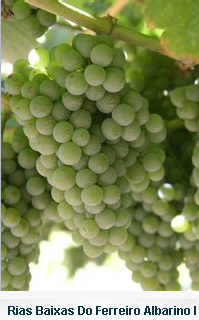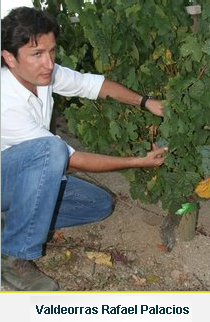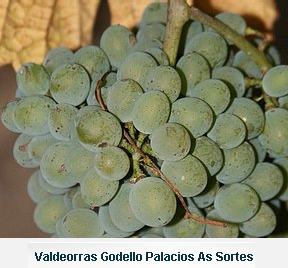|  Ribeira
Sacras :
After several days in Rías Baixas
marked by some lovely wines, but also plagued by arson (fire
destroyed some of Do Ferreiro’s
vines, among others), I turned west toward Ribeira
Sacra and Valdeorras. The former
has some of Spain’s most spectactularly
beautiful vineyards, which are planted on terraces along
slate-strewn hillsides that plunge steeply to the banks
of lakes created by the dammed-up north-south-flowing Miño
and east-west-flowing Sil
rivers. The Ribeira
Sacra DO has 3,000 acres of the vineyards that
snake through the Galician provinces of Lugo
(in the north) and Orense
(in the south) and is divided into five subzones:
northernmost Chantada
and Ribeiras do Minho
(along the Minho River) [Use Minho,
which is Gallego and Portuguese,
essentially the same language], and Amandi
and Quiroga-Bibei
(along the Sil) — all in Lugo province — and Ribieras do Sil
(along the Orense portion of the
Sil). Ribeira
Sacras :
After several days in Rías Baixas
marked by some lovely wines, but also plagued by arson (fire
destroyed some of Do Ferreiro’s
vines, among others), I turned west toward Ribeira
Sacra and Valdeorras. The former
has some of Spain’s most spectactularly
beautiful vineyards, which are planted on terraces along
slate-strewn hillsides that plunge steeply to the banks
of lakes created by the dammed-up north-south-flowing Miño
and east-west-flowing Sil
rivers. The Ribeira
Sacra DO has 3,000 acres of the vineyards that
snake through the Galician provinces of Lugo
(in the north) and Orense
(in the south) and is divided into five subzones:
northernmost Chantada
and Ribeiras do Minho
(along the Minho River) [Use Minho,
which is Gallego and Portuguese,
essentially the same language], and Amandi
and Quiroga-Bibei
(along the Sil) — all in Lugo province — and Ribieras do Sil
(along the Orense portion of the
Sil).
Ribeira Sacra
is producing some surprisingly good, terroir-laced
red wines from mencía,
Spain’s most exciting rediscovered red variety, but several
promising, still little known, godello-
and albariño-based whites also are grown here. Abadía da
Cova, Ribeira
Sacra’s top bodega, offers a delicious, complex Albariño
accented by the addition of 15 percent godello
and treixadura; a fine
Godello, with 15 percent albariño
added, is also made here. José Manuel Rodríguez,
president of the Ribeira Sacra Consejo Regulador (regulatory council), makes the excellent Décima Godello,
which, with its white peach and mineral flavors, is reminiscent
of viognier. The Godellos of Donandrea Toxeiro
y Peza do Rei
are also delicious.
 Valdeorras:
Just east of Ribeira
Sacra, with 3,700 acres of DO vineyards along the Sil
valley is Valdeorras, which is
showing excellent potential for fine godello-based
whites that reflect their particular terroir.
Valdeorras, which could very well be Spain’s Burgundy,
is attracting more serious winemakers, such as peripatetic
Telmo Rodríguez
and Rafael Palacios (brother of Priorat-La
Rioja-Bierzo winemaking star,
Álvaro
Palacios). They have come here to make rich, fruity,
but well-balanced wines laced with mineral finishes from
old vines godello vineyards terraced
on well-drained slopes; the results are reminiscent of the
best white wines of France. Valdeorras:
Just east of Ribeira
Sacra, with 3,700 acres of DO vineyards along the Sil
valley is Valdeorras, which is
showing excellent potential for fine godello-based
whites that reflect their particular terroir.
Valdeorras, which could very well be Spain’s Burgundy,
is attracting more serious winemakers, such as peripatetic
Telmo Rodríguez
and Rafael Palacios (brother of Priorat-La
Rioja-Bierzo winemaking star,
Álvaro
Palacios). They have come here to make rich, fruity,
but well-balanced wines laced with mineral finishes from
old vines godello vineyards terraced
on well-drained slopes; the results are reminiscent of the
best white wines of France.
After making wines for several years in
his family's Palacios Remondo winery in La Rioja
Baja, including the very well-regarded Placet,
one of the best 100% viura
wines ever made in La Rioja, Rafael
Palacios burst onto the Galician white wine scene in 2005
with As Sortes Godello white, which was in instant sensation. After
a rumored family rift and, perhaps a desire to make his
own mark free of the shadow of his superstar brother, Álvaro,
Rafael moved to Valdeorras (Palacio's
cousins are also making wine there and in neighboring Bierzo)
and procured some high altitude, terraced old vines godello
from which he crafts his signature. When first released
As Sortes will score in the low
90s on just about anyone's scale. It is cask fermented in
foudres (again, a la Alsace) and the wine is left on the lees for
several months in the cask. The resulting wine is Burgundy
weight, richly fruity, mineral-laced, leesy
and without marked oak characteristics, but early on it
exhibits a slightly cloudy, too-deep green-gold color, which,
if it were a sweet wine would not cause concern, but in
a dry white it often means that after a year the wine may
be an downhill oxidative spiral, which I have seen in several
other Spanish white wines vinified this way. One hopes that Palacios will master his
superb godello raw material,
because tastings of his first efforts show the potential to make one
of the great white wines of Europe.
Rodríguez
is the former winemaker of Rioja’s
Remelluri, where
he made some memorable, highly rated reds and one of Rioja’s
most interesting whites from a blend of several native and
foreign varieties. He now makes Telmo
Rodríguez y Cia wines in
such far-flung areas as Ribera
del Duero,
La Rioja, Alicante
and Málaga. Two years ago, he
introduced his first Valdeorras wine, an old vines godello
called Gabo
do Xil. The 2004 was already showing an advanced deep,
green-gold color, but was somewhat out of balance; it did
possess a promising character that made it a wine worth
revisiting in vintages to come. Rodríguez admits that he considers Gabo
do Xil an entry-level Godello,
but the 2005, which I tasted over dinner with young star
chef Vicente Patiño's food at Sal de Mar restaurant
in Denia (Alicante) in January, was silky, spicy, delicious and performed
well above Telmo's own advance
billing for the wine.
 A
Valdeorras godello-based
wine with a longer history is Godeval,
which shows the flinty, mineral terruño
(terroir) from the pizzara- (slate)
strewn slopes around a refurbished old monastery that is
the winery. In its early years, Godeval
reached depths of flavor and complexity that few other native
Spanish whites achieve. It has become quite popular over
the past few years, however, and, though still quite good,
it may have slipped slightly as its production has grown
to meet demand. Godeval also makes a more expensive barrel-fermented godello, but the oak obscures the wine’s nuances and haunting
mineral flavors. A
Valdeorras godello-based
wine with a longer history is Godeval,
which shows the flinty, mineral terruño
(terroir) from the pizzara- (slate)
strewn slopes around a refurbished old monastery that is
the winery. In its early years, Godeval
reached depths of flavor and complexity that few other native
Spanish whites achieve. It has become quite popular over
the past few years, however, and, though still quite good,
it may have slipped slightly as its production has grown
to meet demand. Godeval also makes a more expensive barrel-fermented godello, but the oak obscures the wine’s nuances and haunting
mineral flavors.
La Tapada,
which produces Guitian, uses godello
grown on vineyards around the winery that are distinctly
less rocky than those at Godeval.
José Hidalgo, winemaker at La Rioja’s
Bodegas Bilbaínas,
is La Tapada’s consulting enologists.
Guitian is a pleasant, rich, glossy mouthful of tropical fruit,
but it does not achieve godeval’s
complexity. I tend to discount the barrel-fermented version,
because of its overt butterscotch flavor and a surfeit of
oak, but I recently had to amend that opinion when I tasted
the 1997 and found it surprisingly good. Other Valdeorras 100 percent godello-based
wines of interest are Galiciano
Dia, Joaquín
Rebelledo, Viña
Somoza and Pezas
de Portela. After this
article was almost complete, I tasted the latest vintage
of Pezas de Portela, the 2005, at the trendy Urban
restaurant in the Hotel Urban, perhaps
the hottest new hotel in Madrid.
It was simply stunning, easily as good as many white Burgundies.
Two days later, at Mari Carmen Velez’s
superb La Sirena
restaurant in Petrer, outside
Alicante, I had the 2002, which showed some of
the same fruit and terroir, and
was tasting a lot like aged Burgundy.
There is no doubt that Galicia
is turning out truly fine whites from native grapes. These
refreshingly different varieties — albariño,
godello and treixadura, especially
— are proving themselves capable of producing memorable
wines that are fruity, spicy, often complex, dry, mineral-laced
and excellent companions to food.
That is a revelation in a country thought
as little as decade ago incapable of making world-class
white wines.
First appeared in Wine News Mar-Apr
2007
Gerry Dawes is an
American wine and food writer, specialising in Spain. He
has been traveling to all the nooks and corners of Spain
for more than 30 years. In 2003, he was awarded the Marqués
de Busianos Spanish National Gastronomy Prize.
.
|